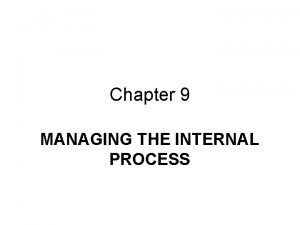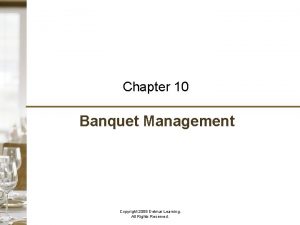Chapter 13 Managing the Function Copyright 2008 Delmar


























































- Slides: 58

Chapter 13 Managing the Function Copyright 2008 Delmar Learning. All Rights Reserved.

Preparing for the Function • Banquet manager MUST plan and organize the minute details to make the function a success • Great service is made up of many moments of truth that the banquet manager must control • If the manager successfully attends to the details, the event will be a success – See Figure 13 -1 Copyright 2008 Delmar Learning. All Rights Reserved.

Preparing for the Function (continued) • The banquet event order (BEO) – Information is used to organize, plan, and manage the event – Distributed to department heads to schedule employees, order food and beverages – Any last-minute changes are forwarded to department heads, highlighting the changes – Guarantee obtained from the client Copyright 2008 Delmar Learning. All Rights Reserved.

Staffing the Event • After the guarantee is received, schedule proper number of employees to serve the party, including bar and kitchen staff – Too few results in slow service Copyright 2008 Delmar Learning. All Rights Reserved.

Staffing the Event (continued) • Service staff needed depends on the – Number of guests at a table – Competency of staff – If staff is covered by union representation, contract states staffing requirements – Generally one service person serves between 16 to 24 guests efficiently Copyright 2008 Delmar Learning. All Rights Reserved.

Staffing the Event (continued) • Bar staff needed – Cocktail reception—either before dinner or by itself – One bartender for every 50 guests – After dinner, one for every 100 guests – Extra bartenders needed • Only for cocktail reception – See Figure 13 -2 Copyright 2008 Delmar Learning. All Rights Reserved.

Staffing the Event (continued) • Kitchen staff – Area where most banquet managers do not give proper consideration • At a banquet, it is extremely important to serve the guests as quickly as possible – Kitchen MUST be organized—Figure 13 -3 and Figure 13 -4 • Industry guideline to serve one course – 100 guests in a maximum of 10 minutes Copyright 2008 Delmar Learning. All Rights Reserved.

Planning for the Equipment • BEO – Contains information needed for planning the equipment • Banquet manager determines exactly what plates and utensils are needed – See page 358, Lockwood wedding • Banquet checklist – See Figure 13 -5 Copyright 2008 Delmar Learning. All Rights Reserved.

Planning for the Needed Extra Equipment • Need extra equipment such as – Salt and pepper shakers – – Cream containers • Guests never have to ask for any item – See Figure 13 -6 Copyright 2008 Delmar Learning. All Rights Reserved.

Planning for the Needed Extra Equipment (continued) • Need to order extra – Napkins • Used for sidetowels • Center of banquet table – Contrasting color from the table cloth and same color of guest napkins – Bread and butter dishes • Used as coffee shields Copyright 2008 Delmar Learning. All Rights Reserved.

Planning for the Needed Extra Equipment (continued) • Once equipment is calculated, the banquet checklist is completed • Obtain equipment before staff arrives – Can start setting room when clocked-in • No waiting for equipment Copyright 2008 Delmar Learning. All Rights Reserved.

Organizing the Jobs for the Service Staff • Manager plans detailed work schedule – Before employees arrive to work – Prepares a duty roster • Posted in the same location • Three columns – First: Time by which the job must be complete – Second: Who is responsible for doing the job – Third: The specific job to be done – See Figure 13 -7 Copyright 2008 Delmar Learning. All Rights Reserved.

Organizing the Jobs for the Service Staff (continued) • The first job of the day – Manager checks the banquet room to see the physical set up • Once setup is proper, doors guests enter are locked – Prevents guests from entering the room Copyright 2008 Delmar Learning. All Rights Reserved.

Organizing the Jobs for the Service Staff (continued) • Planning the place setting and cover – One setting is set on one table before staff arrives • Called sample setting to eliminate any questions the staff may have – See Figure 13 -8 Copyright 2008 Delmar Learning. All Rights Reserved.

Organizing the Jobs for the Service Staff (continued) • Direction of setting up the room – Proper way to set up room • Set tables farthest from kitchen first – Work back toward the kitchen • If for some reason room is NOT completely set up when guests arrive, staff can continue setting up without carrying items through the guests to the farthest part of the room Copyright 2008 Delmar Learning. All Rights Reserved.

Serving the Party • Four styles of service used in American banquet – Station Method – Follow-up Method – Combination Method – Sweep Method Copyright 2008 Delmar Learning. All Rights Reserved.

Serving the Party (continued) • Station Method – service person is assigned two tables of either 8 or 10 guests— 16 to 20 guests total • Solely responsible for the service at those tables – Best used with large staff of temporary workers • See Figure 13 -9 Copyright 2008 Delmar Learning. All Rights Reserved.

Serving the Party (continued) • Station Method – Advantage • Manager knows who is responsible for service at all tables – Disadvantages • Slowest type of American banquet service • Guests’ tables may not be served in proper order – Potential problem • Service staff setting ONLY their tables Copyright 2008 Delmar Learning. All Rights Reserved.

Serving the Party (continued) • The Follow-up Method – One of the most efficient methods – Quickest service if staff can master the system – Takes planning, cooperation, and leadership – Staff divide into two teams, each responsible for one half of the room • See Figure 13 -10 Copyright 2008 Delmar Learning. All Rights Reserved.

Serving the Party (continued) • The Follow-up Method – When time to clear dirty dishes, all team members work together removing the dishes • Work from head table backwards toward kitchen – Advantages • Fast service and guests served in proper order – Disadvantage • Difficult to teach to temporary help Copyright 2008 Delmar Learning. All Rights Reserved.

Serving the Party (continued) • The Combination Method – Combines best features of the Follow-up and Station Methods • Food is served by the team system – Clearing dirty dishes and serving beverages – Service person responsible for a station Copyright 2008 Delmar Learning. All Rights Reserved.

Serving the Party (continued) • The Combination Method – Advantages • Can be taught to permanent or temporary staff – Only key people are head service people • Tables are served in proper order • Confusion of service staff eliminated – Disadvantage • Slower than Follow-up Method Copyright 2008 Delmar Learning. All Rights Reserved.

Serving the Party (continued) • The Sweep Method – Best used when one entrée is offered – Utilizes speed and organization – Room is divided into sections • Each section has – A Banquet supervisor – Service persons to serve beverages Copyright 2008 Delmar Learning. All Rights Reserved.

Serving the Party (continued) • The Sweep Method – Most service staff divided into teams • Luggers —Carry food from kitchen, dirty dishes to dish room – Look for banquet supervisor—delivers tray by them • Servers —Serve the food and clear dirty dishes – Takes plates off trays—serves the guests • When table is completely served, banquet supervisor moves to next table with the traystand Copyright 2008 Delmar Learning. All Rights Reserved.

Serving the Party (continued) • The Sweep Method – Once all guests have been served • Method differs from other methods – Team returns to front section to start removing finished plates of guests who were served first – Staff DOES NOT wait until all guests are finished eating to remove the dirty plates Copyright 2008 Delmar Learning. All Rights Reserved.

Serving the Party (continued) • The Sweep Method – Speeds up service of the banquet – As soon as all plates are cleared, luggers carry out the next course Copyright 2008 Delmar Learning. All Rights Reserved.

Serving the Party (continued) • Banquet manager should decide which system to use based upon – Capabilities of the staff – Organizational qualities of the manager • Whichever method is used, the banquet manager MUST be in the room at all times when – Food is being served – Dishes are being cleared Copyright 2008 Delmar Learning. All Rights Reserved.

Proper Order of Serving the Party • MUST know the correct order in which to serve the guests • Head table is always served first – Next are tables in front of the head table • Service follows a logical manner, going from head table to the back of the room • See Figure 13 -11 Copyright 2008 Delmar Learning. All Rights Reserved.

Serving Cocktail Parties • Guests obtain first impression of service at the cocktail reception – Bar manager—responsible for bartenders – Chef—responsible for cooks • Food being served should be ample enough to provide the guests with appetizers before the meal, BUT not so ample that it spoils their appetite Copyright 2008 Delmar Learning. All Rights Reserved.

Serving Cocktail Parties (continued) • Passed hors d’oeuvres – Called “Butler Style” • Food carried on trays with cocktail napkins, which are offered to the guests when hors d’oeuvre is taken • Staff HAS to be – Knowledgeable about ALL items on tray – Able to explain items to the guests – Staff circulates throughout the room, offering food, picking up dirty plates and glasses Copyright 2008 Delmar Learning. All Rights Reserved.

Serving Cocktail Parties (continued) • Tips about cocktail parties – Always position bars away from • Entrances to the room • Food tables – Stagger service of hors d’oeuvres – Combine butler style with hot and cold stations, most elegant type of service – Plan about 5 pieces of food person at a cocktail party before a meal Copyright 2008 Delmar Learning. All Rights Reserved.

Serving Cocktail Parties (continued) • Tips about cocktail parties – • Controversial issue —check policy of establishment – Ending the cocktail reception must have a method that does NOT offend the client • Involves tact and diplomacy • Bars need to shut down —finish serving drinks – Inform guests bar is closed – Walk away from the bar Copyright 2008 Delmar Learning. All Rights Reserved.

Running the Banquet Party • When doors are unlocked, the room is completely set to receive guests – Main responsibility of the banquet manager is to get all the guests seated and the meal served • Easy if seating assignments are made • More difficult if no seating assignments are made Copyright 2008 Delmar Learning. All Rights Reserved.

Running the Banquet Party (continued) • Serving and clearing the meal – Once all guests are seated and introductions, blessings, or toasts have been given, staff can serve the meal – Communication between the banquet manager and chef is a MUST for a successful banquet Copyright 2008 Delmar Learning. All Rights Reserved.

Running the Banquet Party (continued) • Giving the number to the chef – Inform the chef about the progress of the party – Give verified number of guests to the chef to make adjustments on the food – When late guests arrive, inform the chef immediately Copyright 2008 Delmar Learning. All Rights Reserved.

Running the Banquet Party (continued) • Obtain guest preference for main course – When more than one entrée is offered, use color tickets at the place setting • Each color represents a particular entrée – Service staff collects and records who gets what – All guests at one table are served at approximately the same time Copyright 2008 Delmar Learning. All Rights Reserved.

Controlling the Function • Clients pay their bill based upon the number of meal tickets collected – Person in kitchen collects tickets from service staff – At a buffet—Person stationed at the front of the buffet line collects tickets – If there is a discrepancy, count the number of guests with the client • Use the confirmed count Copyright 2008 Delmar Learning. All Rights Reserved.

Buffets • Manager is responsible for having buffet set up and ready for the guests at the scheduled time • A few basic principles – Serve hot food hot, cold food cold – Arrange buffet lines so guests don’t wait – Keep buffets looking neat • See Figure 13 -12 Copyright 2008 Delmar Learning. All Rights Reserved.

Buffets (continued) • Use of buffets – Great for clients who want guests to have choices – When function rooms are limited, food is served in same room – Buffet tables on wheels can be rolled into a room when guests are ready to eat Copyright 2008 Delmar Learning. All Rights Reserved.

Buffets (continued) • Flow and layout of the buffet – Have separate islands for different parts of the meal – One buffet line for every 100 guests – All condiments are placed in front of or next to the food they accompany • Proper utensils for use of condiments are placed nearby Copyright 2008 Delmar Learning. All Rights Reserved.

The Setup of the Buffet • First item in line: Clean plates – Check top and bottom of plates for cleanliness • Usually arranged in the same manner as a meal is served • See Figure 13 -13 and Figure 13 -14 Copyright 2008 Delmar Learning. All Rights Reserved.

The Setup of the Buffet (continued) • Service staff jobs at a buffet – Depends on the style of buffet – Service person positioned behind line • Assisting guests by portioning out the food • Answer questions about the food • Clean up any spills • Keep buffet line moving • Replenish food • Keep buffet line neat and clean Copyright 2008 Delmar Learning. All Rights Reserved.

The Setup of the Buffet (continued) • Service staff jobs at a buffet – Service person instructed to replenish food when there is between 1/3 to 1/4 remaining in tray or pan – Runner obtains the food from the kitchen • Switches trays in chafing dish – NOT mixing food from the line to the new tray Copyright 2008 Delmar Learning. All Rights Reserved.

The Setup of the Buffet (continued) • Controlling the traffic flow – Guests proceed to the buffet line in an organized fashion – Banquet manager announces • Which table may proceed to the buffet – Host’s table is invited first to proceed to the buffet – If client requested quick buffet service • More than one buffet needs to be set up • Double-sided buffet line Copyright 2008 Delmar Learning. All Rights Reserved.

The Setup of the Buffet (continued) • Chafing dishes – Used to keep hot food hot – Act like a portable steam table – Use canned heat—Sternos • To heat water in an underliner pan – Steam created keeps food hot • MUST check Sternos during service – Replace if empty Copyright 2008 Delmar Learning. All Rights Reserved.

The Setup of the Buffet (continued) • Carvers – Stationed at a food station – Carve hot items like • • • – Fee for a carver should be clearly stated in the policy sheet Copyright 2008 Delmar Learning. All Rights Reserved.

Final Tip on Buffet Setups • Should look appetizing – Display food with imagination • Use height for trays • Use trays with pedestals – Stand back and look at the buffet • Make adjustments as necessary Copyright 2008 Delmar Learning. All Rights Reserved.

Final Tip on Buffet Setups (continued) • Keeping food hot – In addition to chafing dishes • Hot boxes used to keep food hot – Either electrically or using Sternos – Food stored and wheeled to the location of the event • Food is served on warm plates – Cold plates lead to cold food Copyright 2008 Delmar Learning. All Rights Reserved.

The Sequence of Service for a Sit-Down Meal • Use the Lockwood wedding as a guide – Refer to pages 382– 383 – Eleven steps used • Banquet manager MUST be flexible when serving a meal – Make adjustments to satisfy the needs of the guests Copyright 2008 Delmar Learning. All Rights Reserved.

Problems with Latecomers and Early-Leavers • If guests are late, serve them the course they desire as quickly as possible • If guests need to leave early, possibly serve main course while guests eat the salad Copyright 2008 Delmar Learning. All Rights Reserved.

Banquet Checkbacks • Imperative to check satisfaction of ALL guest tables after main course has been served to determine whether the meal and service were satisfactory – Done by observing the guest’s plates • A fact to remember – Influencing one guest at a banquet has the potential to sell an additional banquet for many guests Copyright 2008 Delmar Learning. All Rights Reserved.

Banquet Checkbacks (continued) • It is easier to obtain business from people who have experienced your operation than to create a whole new market • Throughout the event, the manager should be constantly communicating with the client Copyright 2008 Delmar Learning. All Rights Reserved.

Managing the Meeting Room Business • Knowing the correct way to manage the meeting room business is important for repeat business • Make sure that all items are in place and the room is set up correctly before the guests arrive Copyright 2008 Delmar Learning. All Rights Reserved.

Managing the Meeting Room Business (continued) • Timing is critical for breaks – During the break, the banquet manager should have a staff member service the room • Replenish the water • Freshen up the room – Replenish snacks – Take out garbage Copyright 2008 Delmar Learning. All Rights Reserved.

Presenting the Bill to the Host and Rebooking the Party • Banquet manager’s last jobs of the day – Presenting and explaining the bill • Payment should be obtained and CLIENT should be THANKED – If the event is an annual event, ask the client whether he or she wants to rebook for the following year Copyright 2008 Delmar Learning. All Rights Reserved.

Breakdown of the Function • Once guests have departed, there is still work to be done • Banquet manager needs a system for cleaning up the dining room – Dirty dishes and equipment must be brought into the kitchen in an organized fashion • Once cleaned to your satisfaction, thank and dismiss the employees Copyright 2008 Delmar Learning. All Rights Reserved.

Lawsuits and the Restaurant • Food service industry has been sued increasingly by guests who claim personal injury/harm – See pages 389– 391 for examples • Many, if not most, lawsuits can be prevented through good management practices Copyright 2008 Delmar Learning. All Rights Reserved.

A Final Tip • Tip Reporting Alternative Commitment (TRAC) requires employers to take an active role in educating and reeducating their employees, quarterly, about their tip reporting requirements Copyright 2008 Delmar Learning. All Rights Reserved.
 2008 2008
2008 2008 Copyright 2008
Copyright 2008 Copyright 2008
Copyright 2008 Copyright 2008
Copyright 2008 Redistribution prohibited
Redistribution prohibited 2008 pearson prentice hall inc
2008 pearson prentice hall inc Copyright 2008
Copyright 2008 Copyright 2008
Copyright 2008 Chapter 6:2 interpreting word parts
Chapter 6:2 interpreting word parts 2009 delmar cengage learning
2009 delmar cengage learning Introduction to medical terminology chapter 1
Introduction to medical terminology chapter 1 Graphing tpr
Graphing tpr Delmar isotonic
Delmar isotonic Delmar tsi
Delmar tsi Delmar custom broker
Delmar custom broker Delmar thomson learning
Delmar thomson learning 2009 delmar cengage learning
2009 delmar cengage learning Chapter 13 medical math
Chapter 13 medical math Chapter 10 cultural diversity
Chapter 10 cultural diversity Delmar larsen
Delmar larsen Delmar cengage learning instructor resources
Delmar cengage learning instructor resources Chapter 9 managing the internal audit function
Chapter 9 managing the internal audit function Chapter 9 managing the internal audit function
Chapter 9 managing the internal audit function Hình ảnh bộ gõ cơ thể búng tay
Hình ảnh bộ gõ cơ thể búng tay Frameset trong html5
Frameset trong html5 Bổ thể
Bổ thể Tỉ lệ cơ thể trẻ em
Tỉ lệ cơ thể trẻ em Chó sói
Chó sói Tư thế worms-breton
Tư thế worms-breton Chúa yêu trần thế
Chúa yêu trần thế Kể tên các môn thể thao
Kể tên các môn thể thao Thế nào là hệ số cao nhất
Thế nào là hệ số cao nhất Các châu lục và đại dương trên thế giới
Các châu lục và đại dương trên thế giới Công thức tính độ biến thiên đông lượng
Công thức tính độ biến thiên đông lượng Trời xanh đây là của chúng ta thể thơ
Trời xanh đây là của chúng ta thể thơ Mật thư anh em như thể tay chân
Mật thư anh em như thể tay chân 101012 bằng
101012 bằng độ dài liên kết
độ dài liên kết Các châu lục và đại dương trên thế giới
Các châu lục và đại dương trên thế giới Thơ thất ngôn tứ tuyệt đường luật
Thơ thất ngôn tứ tuyệt đường luật Quá trình desamine hóa có thể tạo ra
Quá trình desamine hóa có thể tạo ra Một số thể thơ truyền thống
Một số thể thơ truyền thống Cái miệng bé xinh thế chỉ nói điều hay thôi
Cái miệng bé xinh thế chỉ nói điều hay thôi Vẽ hình chiếu vuông góc của vật thể sau
Vẽ hình chiếu vuông góc của vật thể sau Nguyên nhân của sự mỏi cơ sinh 8
Nguyên nhân của sự mỏi cơ sinh 8 đặc điểm cơ thể của người tối cổ
đặc điểm cơ thể của người tối cổ Giọng cùng tên là
Giọng cùng tên là Vẽ hình chiếu đứng bằng cạnh của vật thể
Vẽ hình chiếu đứng bằng cạnh của vật thể Phối cảnh
Phối cảnh Thẻ vin
Thẻ vin đại từ thay thế
đại từ thay thế điện thế nghỉ
điện thế nghỉ Tư thế ngồi viết
Tư thế ngồi viết Diễn thế sinh thái là
Diễn thế sinh thái là Dạng đột biến một nhiễm là
Dạng đột biến một nhiễm là Số nguyên tố là số gì
Số nguyên tố là số gì Tư thế ngồi viết
Tư thế ngồi viết Lời thề hippocrates
Lời thề hippocrates Thiếu nhi thế giới liên hoan
Thiếu nhi thế giới liên hoan


















































































